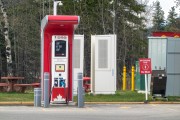The curbside is a commonly neglected piece of the urban landscape. When we think about our transportation networks, we are often preoccupied with roads, sidewalks, or bike lanes—it’s easy for us to forget about the space in-between. But this in-between space is a critical part of the transportation network for everyone. We see these sights – or hear the honking — every day: vehicle drivers trying to parallel park, transit users trying to step off the streetcar or bus safely, delivery truck drivers needing to unload goods while staying on schedule, ride hailing or taxi passengers opening a car door while (hopefully) watching for cyclists — or on the flip side, a cyclist trying desperately not to get “doored”.
In the City of Toronto, competition for the curbside is intensifying as transportation patterns and behaviours change. We’re seeing a growing number of trucks seeking loading areas to make deliveries as online shopping and the demand for home delivery increases. As well, as ride hailing services and cycling become more common modes of transportation, more road users are competing for the same curb space. Exciting advancements in active transportation, like last week’s announcements for the Danforth bike lane pilot, and the Bloor bike lane extension, are great opportunities to raise the curbside management conversation.
We’re pleased that the City of Toronto recognizes the need to manage curbside competition and is currently implementing their Curbside Management Strategy, which was approved by city council in 2017. The strategy calls for 18 implementation tactics, including quick wins and short- and medium-term solutions, to improve the management of curbside space in the city. Many of these tactics encourage off-street curbside use, such as using laneways for loading/unloading activities, reducing curbside demand during peak hours, providing alternative spaces for vehicles to stop or park, and improved communication, monitoring, and enforcement tactics for vehicle parking.
As mentioned above, the city also updated its Cycling Network Plan last week to connect, grow, and renew Toronto’s existing cycling network. To expedite the implementation of the city’s cycling plan while addressing curbside management issues, there is an untapped opportunity to generate and showcase broader consensus and buy-in for the cycling network from those outside of the cycling community.
We believe that one way to do this is to explore how the design and operations of cycling infrastructure in conjunction with the curbside can be reimagined to better serve the needs and ensure the safety of all curbside users. Well-designed cycling infrastructure and tactics to manage curbside competition can decrease safety risks and create clearer rules around sharing curbside space. The transportation system needs to be looked at holistically, and that’s why curbside management is important not just for cycling and creating complete communities, but also for urban goods movement, as demonstrated in our recent feasibility study of cargo cycles and micro delivery hubs.
In this vein, the Pembina Institute sees an opportunity to further our engagement with all curbside users, particularly those involved in the goods movement sector, to help advance the city’s related planning initiatives. In the coming months, we seek to identify three locations in the city that are high conflict areas between cyclists and goods movement activity. Through best practice research and stakeholder consultation, we will develop a set of design principles and operational tactics that address the needs and improve the safety of all curbside users specific to these three case study locations. In doing so, we aim to generate support from new voices in support of the city’s Cycling Network Plan — especially in light of last week’s bike lane pilot and extension announcements — while helping businesses improve the efficiency and safety of their urban delivery operations.
Ultimately, expanding Toronto’s cycling network and improving curbside management is in everyone’s best interest. Not only will this increase the safety and efficiency of our transportation system for both passenger and goods movement, but it will help reduce carbon emissions from the transportation sector, resulting in cleaner air and keeping us on the right track for achieving our climate goals.







